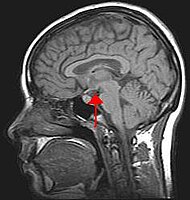
Photo from wikipedia
Circadian desynchrony induced by a long period of irregular feeding leads to metabolic diseases, such as obesity and diabetes mellitus. The recently identified neurosecretory protein GL (NPGL) and neurosecretory protein… Click to show full abstract
Circadian desynchrony induced by a long period of irregular feeding leads to metabolic diseases, such as obesity and diabetes mellitus. The recently identified neurosecretory protein GL (NPGL) and neurosecretory protein GM (NPGM) are hypothalamic small proteins that stimulate food intake and fat accumulation in several animals. To clarify the mechanisms that evoke feeding behavior and induce energy metabolism at the appropriate times in accordance with a circadian rhythm, diurnal fluctuations in Npgl and Npgm mRNA expression were investigated in mice. Quantitative RT-PCR analysis revealed that the mRNAs of these two genes were highly expressed in the mediobasal hypothalamus during the active dark phase under ad libitum feeding. In mice restricted to 3 h of feeding during the inactive light phase, the Npgl mRNA level was augmented in the moment prior to the feeding period and the midnight peak of Npgm mRNA was attenuated. Moreover, the mRNA expression levels of clock genes, feeding regulatory neuropeptides, and lipid metabolic enzymes in the central and peripheral tissues were comparable to those of central Npgl and Npgm. These data suggest that Npgl and Npgm transcription fluctuates daily and likely mediates feeding behavior and/or energy metabolism at an appropriate time according to the meal timing.
Journal Title: International Journal of Molecular Sciences
Year Published: 2021
Link to full text (if available)
Share on Social Media: Sign Up to like & get
recommendations!